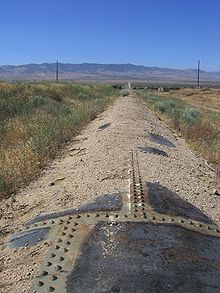Main article: Aqueduct (watercourse)
The Los Angeles Aqueduct in Antelope Valley.
Pipelines are useful for transporting water for drinking or irrigation over long distances when it needs to move over hills, or where canals or channels are poor choices due to considerations of evaporation, pollution, or environmental impact.
The 530 km (330 mi) Goldfields Water Supply Scheme in Western Australia using 750 mm (30 inch) pipe and completed in 1903 was the largest water supply scheme of its time.[23][24]
Examples of significant water pipelines in South Australia are the Morgan-Whyalla pipelne (completed 1944) and Mannum-Adelaide (completed 1955) pipelines, both part of the larger Snowy Mountains scheme.[25]
There are two Los Angeles, California aqueducts, the Owens Valley aqueduct (completed 1913) and the Second Los Angeles Aqueduct (completed 1970) which also include extensive use of pipelines.
The Great Manmade River of Libya supplies 3,680,000 cubic metres (4,810,000 cu yd) of water each day to Tripoli, Benghazi, Sirte, and several other cities in Libya. The pipeline is over 2,800 kilometres (1,700 mi) long, and is connected to wells tapping an aquifer over 500 metres (1,600 ft) underground.[26]

No comments:
Post a Comment